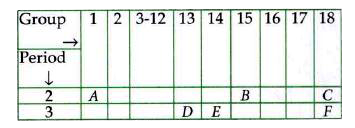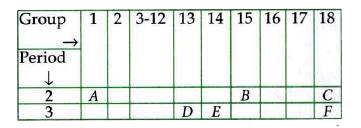Six elements of periodic table A, B, C, D, E and F have atomic numbers of 2, 12, 20, 18, 4 and 10 respectively (where A, B, C, D, E and F are not the chemical symbols of these elements). Based on this information, answer the following questions :
What values are indicated in a student in answering the above questions?
First of all, write the electronic configurations of all the given six elements as follows:

Answering these questions by a student are indicating awareness towards modern periodic classification of the elements and ability to apply his knowledge in solving the related questions.
Topper's Solved these Questions
- PERIODIC CLASSIFICATION OF ELEMENTSBOOK - KUMAR PRAKASHANCHAPTER - PERIODIC CLASSIFICATION OF ELEMENTSEXERCISE - Practical Skill Based Questions With Answers
2 Videos
- PERIODIC CLASSIFICATION OF ELEMENTSBOOK - KUMAR PRAKASHANCHAPTER - PERIODIC CLASSIFICATION OF ELEMENTSEXERCISE - Acitivity 5.2
2 Videos
- PERIODIC CLASSIFICATION OF ELEMENTSBOOK - KUMAR PRAKASHANCHAPTER - PERIODIC CLASSIFICATION OF ELEMENTSEXERCISE - OBJECTIVE QUESTIONS AND ANSWERS ((C ) )
1 Videos
- MODEL QUESTION PAPER 01BOOK - KUMAR PRAKASHANCHAPTER - MODEL QUESTION PAPER 01EXERCISE - (SECTION-A) (MCQs)
1 Videos
- QUESTION PAPER-2 (MARCH,2020 - BOARD'S QUESTIONS PAPER)BOOK - KUMAR PRAKASHANCHAPTER - QUESTION PAPER-2 (MARCH,2020 - BOARD'S QUESTIONS PAPER)EXERCISE - Section - D (Answer the following questions)
3 Videos
Similar Questions
Rohan was told that six elements A,B, C,D,E and F have atomic numbers of 2,12,20,18,4 and 10 respectively (where A,B,C,D,E and F are not the chemical symbols of these elements). Based on this information, Rohan was asked to answer the following questions:
(a) Which of these elements belong to the same groups of the periodic table? Why?
(b) Which of these element belong tothe same periods of the periodic table? Why?
(c) Which of these elements are (i) metals, and (ii) non-metals?
(d) Which of these elements are chemically (i) reactive and (ii) unreactive?
(e) What values are displayed by Rohan in answering the above questions?
View SolutionWhat valencies will be shown by the elements A, B, C, D and E having atomic numbers 2, 4, 8, 10 and 13 respectively.
View Solution
Knowledge Check
Five elements A,B,C,D and E have atomic numbers of 2,3,7,10 and 18 respectively. The elements which belong to the same period of the periodic table are :
AA,B,CBB,C,DCA,D,EDB,D,E
In the following table, six elements A, B, C, D, E and F (here letters are not the usual symbols of the elements) of the modern periodic table with their atomic numbers are given.

Which of these is an inert gas ?
View SolutionIn the following table, six elements A, B, C, D, E and F (here letters are not the usual symbols of the elements) of the modern periodic table with their atomic numbers are given.

Which of these are metals?
View SolutionIn the following table, six elements A, B, C, D, E and F (here letters are not the usual symbols of the elements) of the modern periodic table with their atomic numbers are given.

Which of these is a halogen ?
View SolutionStudy the following table in which positions of six elements A, B, C, D, E and F are shown as they are in the modern periodic table

On the basis of the above table, answer the following questions
Name the element which is a metal with valency three
View SolutionIn the following table, six elements A, B, C, D, E and F (here letters are not the usual symbols of the elements) of the modern periodic table with their atomic numbers are given.

If B combines with F, what would be the formula of the compound formed?
View SolutionStudy the following table in which positions of six elements A, B, C, D, E and F are shown as they are in the modern periodic table

On the basis of the above table, answer the following questions
Name the element which is a non-metal iwth valency three
View SolutionStudy the following table in which positions of six elements A, B, C, D, E and F are shown as they are in the modern periodic table

On the basis of the above table, answer the following questions
Out of D and E, which is bigger in size and why?
View Solution
